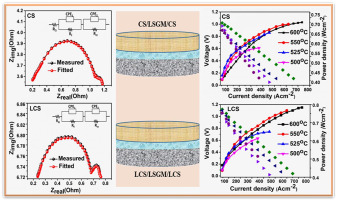当前位置:
X-MOL 学术
›
Solid State Sci.
›
论文详情
Our official English website, www.x-mol.net, welcomes your feedback! (Note: you will need to create a separate account there.)
Metal oxide nanocomposites as anode and cathode for low temperature solid oxide fuel cell
Solid State Sciences ( IF 3.5 ) Pub Date : 2020-04-01 , DOI: 10.1016/j.solidstatesciences.2020.106162 Kausar Shaheen , Zarbad Shah , Hussain Gulab , Muhammad Bilal Hanif , Shah Faisal , Hongli Suo
Solid State Sciences ( IF 3.5 ) Pub Date : 2020-04-01 , DOI: 10.1016/j.solidstatesciences.2020.106162 Kausar Shaheen , Zarbad Shah , Hussain Gulab , Muhammad Bilal Hanif , Shah Faisal , Hongli Suo

|
Abstract The high operating temperature for Solid Oxide Fuel Cells (SOFCs) is one of the major obstacles in the advancement and marketing of the fuel cell technology. Mixed metal oxides Cu0.5Sr0.5 (CS) and La0.2 doped Cu0.4Sr0.4 (LCS) nanocomposites, fabricated through a mild and cost effective pechini method were used as an efficient remedy in this context. The nanocomposites were evaluated for phase purity and structural analysis through X-Ray Diffractometer (XRD) and Scanning Electron Microscope (SEM). Particle size calculated was ~37.21 nm (for CS) and 62.43 nm (for LCS) via XRD, while SEM revealed the size ranged from (43–72) nm. Performance of the symmetrical triple layered cells was tested in the temperature range of 500–600 °C with H2 fuel. LCS nanocomposites exhibited higher electrical conductivity ~4.70 S/cm and greater power density ~782 mW/cm2 as compared to CS nanocomposites for which the electrical conductivity and power density were achieved as 4.40 S/cm and 725 mW/cm2 respectively. The activation energy for CS and LCS were found to be 0.23 and 0.26eV respectively. The reliable and enhanced power densities make the synthesized nanocomposites as potential candidates for low temperature SOFCs as anode and cathode.
中文翻译:

金属氧化物纳米复合材料作为低温固体氧化物燃料电池的阳极和阴极
摘要 固体氧化物燃料电池(SOFC)的高工作温度是燃料电池技术进步和市场推广的主要障碍之一。混合金属氧化物 Cu0.5Sr0.5 (CS) 和 La0.2 掺杂的 Cu0.4Sr0.4 (LCS) 纳米复合材料,通过温和且具有成本效益的 Pechini 方法制造,在这种情况下被用作有效的补救措施。通过 X 射线衍射仪 (XRD) 和扫描电子显微镜 (SEM) 评估纳米复合材料的相纯度和结构分析。通过 XRD 计算出的粒径为 ~37.21 nm(对于 CS)和 62.43 nm(对于 LCS),而 SEM 显示的粒径范围为(43-72)nm。对称三层电池的性能在 500-600 °C 的温度范围内使用 H2 燃料进行测试。LCS 纳米复合材料表现出更高的电导率~4。与电导率和功率密度分别达到 4.40 S/cm 和 725 mW/cm2 的 CS 纳米复合材料相比,70 S/cm 和更高的功率密度~782 mW/cm2。发现 CS 和 LCS 的活化能分别为 0.23 和 0.26eV。可靠且增强的功率密度使合成的纳米复合材料成为低温 SOFC 阳极和阴极的潜在候选者。
更新日期:2020-04-01
中文翻译:

金属氧化物纳米复合材料作为低温固体氧化物燃料电池的阳极和阴极
摘要 固体氧化物燃料电池(SOFC)的高工作温度是燃料电池技术进步和市场推广的主要障碍之一。混合金属氧化物 Cu0.5Sr0.5 (CS) 和 La0.2 掺杂的 Cu0.4Sr0.4 (LCS) 纳米复合材料,通过温和且具有成本效益的 Pechini 方法制造,在这种情况下被用作有效的补救措施。通过 X 射线衍射仪 (XRD) 和扫描电子显微镜 (SEM) 评估纳米复合材料的相纯度和结构分析。通过 XRD 计算出的粒径为 ~37.21 nm(对于 CS)和 62.43 nm(对于 LCS),而 SEM 显示的粒径范围为(43-72)nm。对称三层电池的性能在 500-600 °C 的温度范围内使用 H2 燃料进行测试。LCS 纳米复合材料表现出更高的电导率~4。与电导率和功率密度分别达到 4.40 S/cm 和 725 mW/cm2 的 CS 纳米复合材料相比,70 S/cm 和更高的功率密度~782 mW/cm2。发现 CS 和 LCS 的活化能分别为 0.23 和 0.26eV。可靠且增强的功率密度使合成的纳米复合材料成为低温 SOFC 阳极和阴极的潜在候选者。



























 京公网安备 11010802027423号
京公网安备 11010802027423号